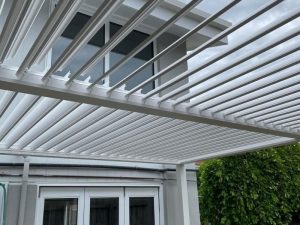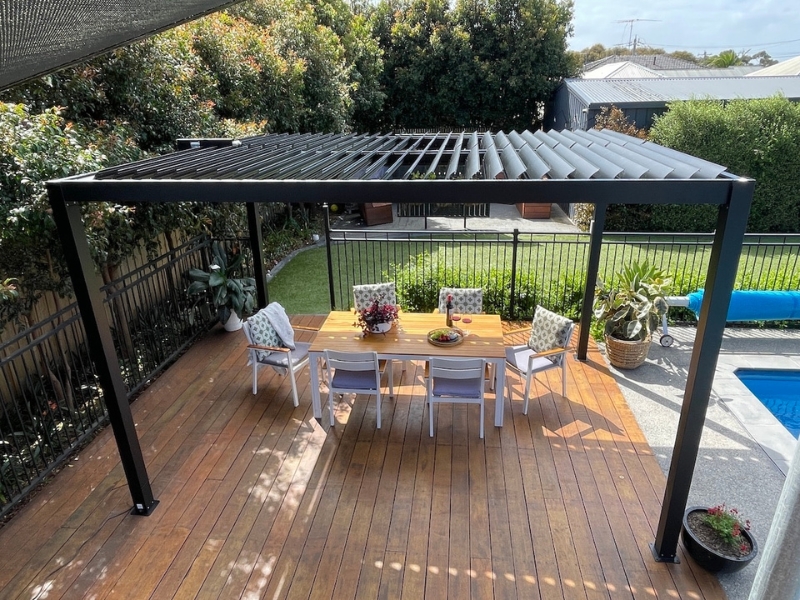Installing a pergola with an adjustable roof isn’t just about style — it’s about getting the timing right. Whether you’re planning for extra summer shade or year-round use, when you install matters. Wet seasons can stall work, while holiday periods slow down approvals and trades. Understanding the smartest time to build saves time, effort, and money. With the right planning, you’ll avoid delays and maximise comfort. This guide breaks down what affects installation timing, how adjustable roofs help across all seasons, and why preparation plays a big role in success.
What climate factors affect pergola installation timing?
Australia’s unpredictable climate makes timing critical. Your build will go smoother if you plan around seasonal weather patterns. Here are the key climate factors that can influence your pergola project:
- Rainfall delays: Heavy rain can prevent post-setting and damage freshly poured concrete, leading to stalled timelines.
- Extreme heat challenges: During heat waves, material expansion and worker fatigue can slow progress and reduce build quality.
- Ideal mild months: Autumn often strikes the right balance — cooler temps and lower rain help projects finish faster.
- Wind disruptions: Strong gusts in coastal or elevated areas can delay frame erection and create site safety concerns.
- Thermal impact: Excess heat or cold affects metal alignment and roof motor calibration during installation.
Why might certain seasons delay a pergola project?
It’s not just the weather — other seasonal quirks can affect how fast your project moves. Here are the non-weather delays that show up in certain seasons:
Season | Potential Delay Factor | Effect on Project Timeline |
Spring | High demand and limited supply | Longer wait times for materials |
Summer | Public holidays and office closures | Delayed council approvals |
Winter | Fewer daylight hours | Reduced daily install time |
School Hols | Limited tradie availability | Rescheduling or extended timelines |
Understanding these timing traps can help you plan ahead, especially when factoring in the seasonal adaptability of adjustable pergolas for year-round use.
How does a pergola with an adjustable roof help year-round?
A fixed-roof structure can limit how and when you enjoy your outdoor space. An adjustable option gives you freedom across all seasons. Here are the year-round benefits of choosing a pergola with an adjustable roof:
- Winter sunlight access: Louvers open wide to let in warm winter sun, turning cold months into comfortable outdoor moments.
- Summer heat control: Close the roof fully during intense heat, creating cool shaded zones for barbecues or lounging.
- Rain protection: Sealed louvres and integrated drainage systems stop downpours from interrupting your plans.
- Furniture safety: UV-blocking coverage keeps your outdoor furniture from fading, cracking, or warping.
- Quick adjustment: Motorised controls let you react instantly to weather shifts, no need to fiddle with panels manually.

No surprise more homeowners are focused on choosing the right motorised pergola for their home — year-round flexibility is a major upgrade.
What preparation is needed before installation begins?
The right prep work means fewer headaches later. From site surveys to council paperwork, smart prep avoids costly delays. Here are the essential preparation steps before starting your pergola install:
- Site levelling: Uneven ground creates drainage issues and unstable posts. Levelling ensures proper frame support and water runoff.
- Clear access routes: Your team needs space to move large posts and panels. Make sure fences, trees, or furniture won’t block them.
- Electrical planning: Motorised features need power. Your electrician should pre-run wiring and ensure outlets are waterproofed.
- Soil testing: Certain soils require deeper foundations or alternate fixing methods — don’t skip this, or the pergola may shift over time.
- Approval process: Drawings and compliance paperwork are often needed. Some councils take weeks to approve, so start early.
If space is tight, these ideas for space-saving pergola layouts can help you prep efficiently without losing function.
Will a pergola with an adjustable roof impact installation time?
You might expect a motorised pergola to take longer, but its design often speeds things up. Here are the ways a pergola with an adjustable roof affects installation time:
- Prefabricated kits: Many adjustable roofs arrive pre-assembled or modular, cutting time spent measuring and building from scratch.
- Integrated features: Built-in gutters and wiring reduce follow-up tasks — it’s a smoother all-in-one process.
- Weather protection: Once the roof is up, it can be used as shelter, helping tradies keep working even during drizzle or sun.
- Smart alignment: The roof’s tilt system allows precise positioning, meaning fewer adjustments during setup.
- Minimal rework: Motorised systems are engineered for balance — once installed correctly, there’s less fiddling or post-install correction.

Even with all this, be sure to check the planning rules for outdoor structures in residential zones to avoid any post-install hiccups.
Is a pergola with an adjustable roof better installed professionally?
DIY can be tempting — until you factor in structural loads, permits, and precision wiring. This isn’t a weekend project. Here are the reasons to leave this installation to the pros:
- Louvre precision: Misaligned blades lead to leaks and jamming. Professionals calibrate each panel to open and seal smoothly.
- Safe wiring: Pergolas with lights, fans, or louvres must meet national electrical codes — waterproofing errors are costly and dangerous.
- Solid footing: Professionals secure posts deep enough to resist wind shear, even on tricky terrain or sloped yards.
- Warranty coverage: Most manufacturers won’t honour product warranties unless it’s installed by certified contractors.
- Paperwork sorted: Experienced teams handle design drawings, council permits, and inspections as part of the service.
The right season makes pergola with adjustable roof installation smarter
Timing isn’t just about weather. It’s about trade availability, approval lead times, and how prepared your site is. Building during a dry, temperate season can speed up installation and reduce material risks. Booking tradies outside peak periods improves your chances of flexible schedules and cost-effective quotes. And most importantly, starting with a clear plan — from permits to power — ensures the whole process runs like clockwork. You’ll spend less time waiting and more time enjoying. If you’re unsure where to begin, you can get expert help from Unique Pergolas for modern pergola plans to move forward with confidence.


